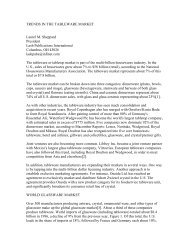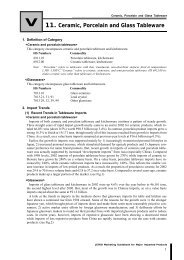eu market survey 2003 - crecer
eu market survey 2003 - crecer
eu market survey 2003 - crecer
Create successful ePaper yourself
Turn your PDF publications into a flip-book with our unique Google optimized e-Paper software.
Cutlery<br />
Included in the cutlery category are kitchen utensils such as knives, ladles and scissors. It also<br />
includes table cutlery like knives, forks and spoons for eating and serving. All types of materials<br />
are included, such as metal, silver, silver plate and stainless steel.<br />
Metalware<br />
The metalware segment includes all types of metals such as silver, silver-plate, stainless steel,<br />
hard-anodised steel, aluminium, etc. Metalware can be divided into five main categories:<br />
• Cookware, including pots, pans and pressure cookers;<br />
• Bakeware, including baking trays and sheets;<br />
• Tableware, including plates as well as holloware;<br />
• Gadgets, such as graters, can openers, garlic crushers and pizza wheels;<br />
• Accessories, such as bread bins, cocktail shakers and trivets.<br />
Woodware<br />
The smallest segment consists of wooden table- & kitchenwares, including products such as<br />
chopping boards, bowls, bread bins and spice racks, all made of wood. Because information on<br />
this segment is very limited, it is not possible to give accurate figures concerning the consumption<br />
of these products.<br />
1.2 Statistical products classification<br />
The nomenclature for statistics within the Europe Union does not specify table- & kitchenware as<br />
such. The trading classification systems used were unified by the introduction of a new,<br />
worldwide coding system, introduced on January 1, 1988. This system is called the Harmonized<br />
Commodity Description System (HS) and was developed by the World Customs Organisation<br />
(WCO). The system comprises about 5,000 commodity groups; each identified by a six-digit<br />
code, arranged in a legal and logical structure, and is supported by well-defined rules to achieve<br />
uniform classification. More than 177 countries and economies use the system as a basis for their<br />
customs tariffs and for the collection of international trade statistics. WCO has introduced some<br />
alterations to the HS and these are included in the combined nomenclature as of January 1, 2002.<br />
After the six-digit code, countries are free to use further subheadings. An 8-digit system is used in<br />
the trade data of Eurostat. Most codes, however, end with two zeros, i.e. effectively only using six<br />
digits. Although in some countries ten digits are occasionally used.<br />
Table 1.1 Harmonised System (HS) classification table- & kitchenware<br />
Product group<br />
Heading HS codes<br />
Plasticware 3924<br />
Woodware 4419<br />
Porcelain & China 6911<br />
Ceramicware 6912<br />
Glassware (incl. crystal) 7013<br />
Metalware 7323 / 7417 / 7418 /7615<br />
Cutlery 8211 / 8215<br />
In order to make this <strong>market</strong> <strong>survey</strong>/guide operational, the <strong>survey</strong> has been limited to describing<br />
the above selected product groups. The HS classification given in Table 1.1 differs in some<br />
extend from the classification mentioned in Paragraph 1.1, which puts limitations to in-depth<br />
interpretation of trade figures and of the possible relationships between import and export figures<br />
on the one hand and production and consumption figures on the other hand. For a more detailed<br />
list of product groups, please refer to Appendix 1.<br />
12





